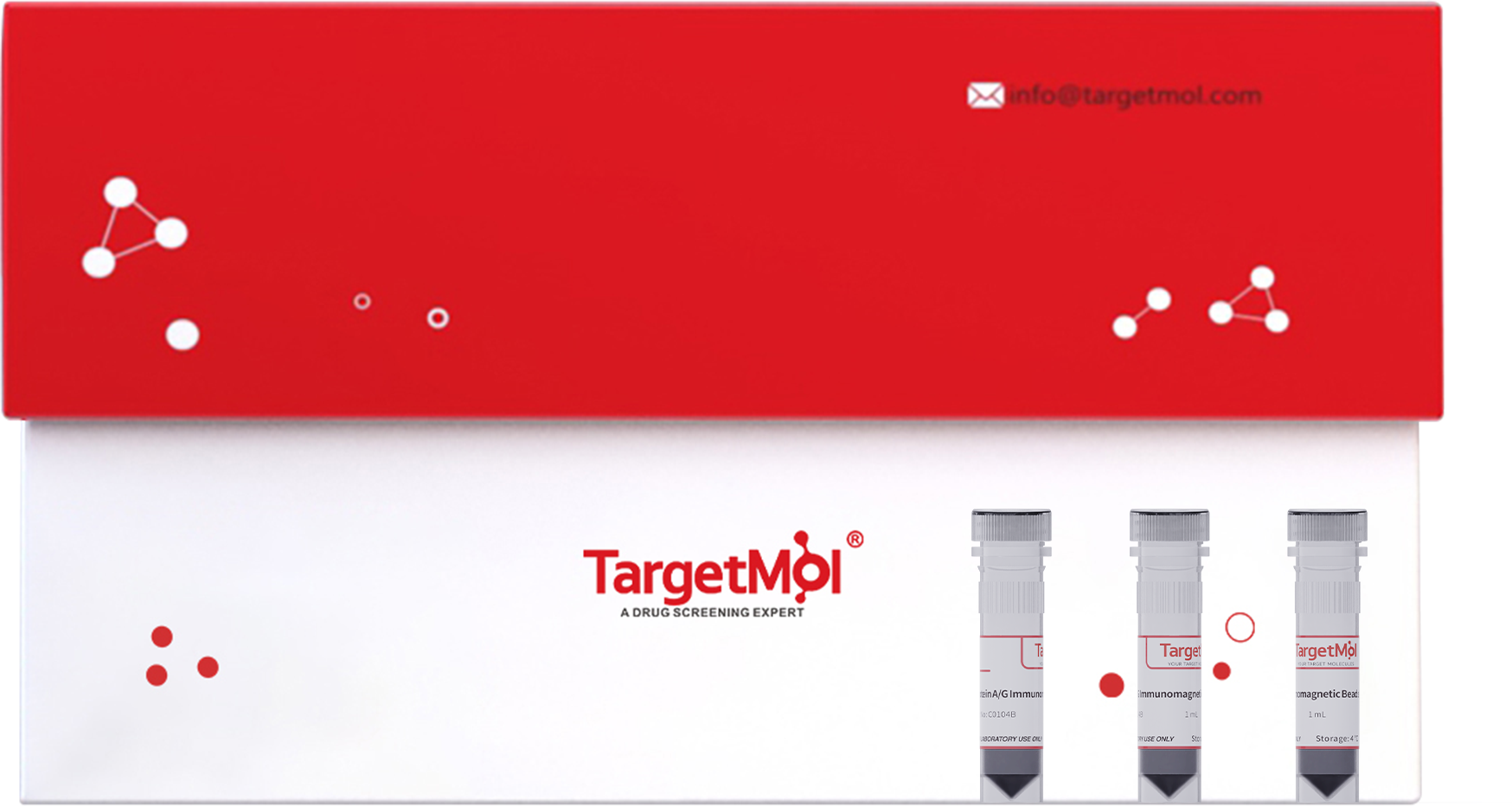 Your shopping cart is currently empty
Your shopping cart is currently empty


Magrose Beads Protein G
The TargetMol Magrose Beads Protein G (30-150 μm) offer an ultra-high specific surface area, significantly reducing the time required for antibody binding. With skilled operation, antibody binding can be completed within 10 minutes, and the entire purification process can be completed within 30 minutes. This product is reusable. Users can select the appropriate bead type based on the species origin and isotype of the target antibody.
| Pack Size | Price | USA Warehouse | Global Warehouse | Quantity |
|---|---|---|---|---|
| 5 mL | $155 | - | In Stock | |
| 5 mL * 5 | $535 | - | In Stock | |
| 5 mL * 10 | $960 | - | In Stock |
 Product Information
Product Information
| Product Name | Magrose Beads Protein A (30-150 μm) (C0106) | Magrose Beads Protein A (10-30 μm) (C0107) | Magrose Beads Protein G (C0108) |
|---|---|---|---|
| Material | Agarose | Agarose | Agarose |
| Bead Size Range | 30-150 µm | 10-30 µm | 30-150 µm |
| Concentration | 10% (V/V) | 10% (V/V) | 10% (V/V) |
| Antibody Binding Capacity (mg Human IgG/mL Gel) | 25-30 | 40-45 | 25-30 |
| Ligand | Protein A | Protein A | Protein G |
| Storage Buffer | PBST, 0.1% (V/V) Proclin 300 | PBS, 0.1% (V/V) Proclin 300, 0.1% (W/V) BSA | PBST, 0.1% (V/V) Proclin 300 |
 Product Features
Product Features
- Extremely high antibody binding capacity with very low nonspecific adsorption.
- Time-saving, simple, and gentle operation. No centrifugation required. Magnetic separation greatly shortens processing time, avoids mechanical shear damage to active proteins caused by centrifugation, and prevents filler loss and handling errors from repeated pipetting.
- High product stability. Antibody binding efficiency shows no significant decline after multiple uses.
- Mild elution system. Antibodies are eluted at pH 4.5, significantly reducing the risk of damage to acid-sensitive antibodies under low pH conditions.
- Very low ligand leakage rate.
- Reusable magnetic beads. Simple regeneration process. After regeneration, antibody binding capacity can recover up to 90% of the original level.
 Product Application
Product Application
- Suitable for antibody purification from samples such as plasma, ascites, and tissue culture supernatants, and also applicable for antibody immobilization and other related studies.
 Instructions
Instructions
1.Buffer Preparation
The following are commonly used buffer compositions suitable for most protein purification applications. Adjustments can be made as needed. It is recommended to filter all buffers through a 0.22 μm or 0.45 μm membrane for sterilization before use.
1)Binding Buffer: PBST (pH 7.2–7.4): 137 mM NaCl, 2.7 mM KCl, 10 mM Na2HP4, 2.0 mM KH2PO4, 0.1% Tween-20.
2)Elution Buffer: 100 mM Gly, 0.1% Tween-20, pH 2.0.
3)Neutralization Buffer: 1.0 M Tris-HCl, pH 9.0.
2.Sample Preparation
Transfer 100 µL of human serum into a 1.5 mL EP tube, add 900 µL of binding/washing buffer, and mix thoroughly.
3.Magnetic Bead Pretreatment
1)Vortex the protein purification magnetic beads thoroughly to ensure complete suspension. Transfer 200 μL of the 10% (V/V) bead suspension into a new 1.5 mL EP tube. Place the tube in a magnetic separator for 1 minute. After magnetic separation, remove the supernatant and take the tube out of the separator.
2)Wash the beads twice with 1 mL of Binding Buffer, performing magnetic separation again. The beads are now ready for antibody separation.
Note: The amount of magnetic beads can be adjusted based on the maximum binding capacity for the target antibody. If the antibody concentration exceeds 150 μg/mL, use 1.2 to 1.5 times the calculated bead volume (Calculation: 1.5*amount of antibody in the sample/maximum bead binding capacity). If the antibody concentration is low (e.g., below 70 μg/mL), the bead volume can be increased up to 3 times to improve recovery.
4.Antibody Binding
1)Add the sample solution prepared in Step 2 to the tube containing pretreated magnetic beads from Step 3 and vortex to mix.
2)Incubate the tube at room temperature (approximately 25 °C) on a rotator or gently invert manually to allow sufficient contact and binding between the sample and the beads. Rotate for approximately 15 minutes.
3)Perform magnetic separation and remove the supernatant. Take the tube off the magnetic separator and proceed to the washing step.
5.Bead Washing
Add 1 mL of Binding Buffer to the EP tube. Vortex to resuspend the beads, then perform magnetic separation and discard the supernatant. Repeat the washing step 3 times.
6. Antibody Elution
1)Add 0.5–1.0 mL of Elution Buffer to the washed magnetic beads. Gently pipette up and down or vortex briefly to quickly resuspend the beads.
2)Incubate the tube at room temperature (approximately 25 °C) on a rotator or gently invert manually for about 10 minutes.
3)Perform magnetic separation and collect the supernatant into a new EP tube.
Note: It is recommended to adjust the volume of Elution Buffer according to the expected antibody concentration, aiming for a final eluted concentration of 0.6–1.2 mg/mL. This ensures that more than 95% of the antibody is effectively recovered during the first elution. If the Elution Buffer volume is insufficient, some antibodies may remain on the beads, reducing recovery efficiency.
7.Antibody Neutralization
Add an appropriate volume of Neutralization Buffer (typically 1/10 of the elution volume) to the eluted antibody solution from Step 6, to adjust the pH to neutral. This helps maintain the biological activity of the antibody and prevents denaturation.
8.Post-treatment of Magnetic Beads
1)Wash the used magnetic beads twice with Elution Buffer, perform magnetic separation, and discard the supernatant.
2)Then wash the beads 3 times with Binding Buffer, perform magnetic separation again, and discard the supernatant.
3)Resuspend the beads in 200 μL of Storage Buffer and store at 2–8 °C for future purification of the same type of protein.
9.Bead Regeneration
With repeated use, impurities such as precipitated proteins, strongly hydrophobic proteins, and lipoproteins may nonspecifically adhere to the surface of the beads. To ensure optimal performance, it is recommended to regenerate the beads after 5 consecutive uses.
1)For every 1 mL of 10% (V/V) magnetic bead suspension, add 1 mL of 1% (V/V) Triton X-100 Regeneration Buffer. Mix thoroughly and incubate at room temperature on a rotator or gently invert manually for 10 minutes. Then perform magnetic separation and discard the supernatant.
2)Immediately add 1 mL of Binding Buffer to resuspend the beads. Perform magnetic separation and discard the supernatant. Repeat this step 3 times.
3)Add 1 mL of Storage Buffer and resuspend the beads. store at 2–8 °C.
 Storage
Storage
Store at 4℃ for 2 years
 Precautions
Precautions
1.Avoid freezing, drying, or high-speed centrifugation of the product.
2.To minimize bead loss, magnetic isolation time should be no less than 1 minute per cycle.
3.Before removing beads from the tube, ensure they are evenly suspended by gentle shaking. Handle gently to prevent the bubbles.
4.It is recommended to use high-quality pipette tips and centrifuge tubes to avoid bead loss due to adhesion.
5.This product is reusable. When purification performance declines, regeneration is recommended.
6.For repeated use, it is advisable to purify the same type of protein. If purifying a different protein, fresh magnetic beads should be used.
7.If the provided buffer system does not yield optimal results, users may adjust or formulate alternative buffers based on their experimental needs.
8.This product is for scientific research use by professionals only and must not be used for clinical diagnosis or treatment, food or drug applications, and must not be stored in residential areas.
9.For your safety and health, wear lab coats and disposable gloves during operation.
 Instruction Manual
Instruction Manual
| Size | Quantity | Unit Price | Amount | Operation |
|---|

Copyright © 2015-2026 TargetMol Chemicals Inc. All Rights Reserved.



